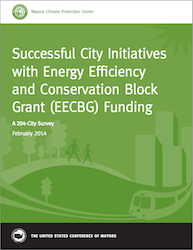This week the mayors from across the U.S. released results of a new survey pointing to successes of cities using Energy Efficiency and Conservation Block Grant (EECBG) program funding under the American Recovery and Reinvestment Act (ARRA) to improve energy efficiency and lower carbon emissions.
 Unveiled by Gresham, Oregon Mayor Shane Bemis, Bridgeport, Connecticut Mayor Bill Finch, and Carmel, Indiana Mayor Jim Brainard, the survey findings derived from the responses of 204 mayors demonstrate how cities invested their EECBG program funds to help further local initiatives to reduce energy use, deploy new energy technologies and curb harmful energy emissions, among other local outcomes. All three mayors are members of the Mayors’ Climate Protection Center.
Unveiled by Gresham, Oregon Mayor Shane Bemis, Bridgeport, Connecticut Mayor Bill Finch, and Carmel, Indiana Mayor Jim Brainard, the survey findings derived from the responses of 204 mayors demonstrate how cities invested their EECBG program funds to help further local initiatives to reduce energy use, deploy new energy technologies and curb harmful energy emissions, among other local outcomes. All three mayors are members of the Mayors’ Climate Protection Center.
“These findings underscore that mayors have been leading by example on energy efficiency and conservation for years,” said Gresham Mayor Shane Bemis, Chair of the Conference’s Energy Committee. “Mayors all across the country have been actively working to advance energy-saving measures in communities large and small, and what we see in this report translates into real budgetary savings, local job creation and small business growth.”
Some of survey’s key findings include:
- The three top uses of EECBG dollars by cities were energy retrofits of government buildings (83 percent of cities), LED/other energy-efficient street lighting (42 percent), and solar energy systems on public buildings and facilities (31 percent).
- Most mayors directed a majority of their EECBG funds to investments in municipal projects and operations. Nearly seven in eight mayors (87%) expended a majority of their EECBG grant dollars on municipal projects and operations.
- LED/other energy-efficient lighting ranked first among energy technologies that have already been deployed by cities, with local and federal resources, most notably EECBG grants, providing the primary sources of funding for these deployments.
- The availability of EECBG funds to cities has influenced city budgetary priorities, and also prompted new partnerships with a range of private sector and governmental entities.
- A majority of mayors cited energy service contracting as the innovative energy financing strategy that EECBG funds helped most often.
Of the report’s findings, Bridgeport Mayor Bill Finch, who Co-Chairs the Conference’s Energy Independence and Climate Protection Task Force noted, “Even as mayors were confronting budget constraints due to the recession and federal spending cuts, this report shows that cities leveraged EECBG dollars by making investments that are still paying dividends today. In my city, we are reducing electricity usage and making solid waste and sewage sludge operations more efficient. So, clearly, this modest federal commitment has bolstered mayors’ efforts to advance energy efficiency, conservation and technology deployment initiatives in their cities.”
 Five years ago, as part of ARRA, EECBG formula grants were distributed directly to cities by the U.S. Department of Energy. Of the $2.7 billion provided to the program in formula funding, about half of these dollars ($1.3 billion) were distributed directly to cities to support their energy and climate efforts, a commitment that ranked among the largest provided to local governments in the ARRA legislation.
Five years ago, as part of ARRA, EECBG formula grants were distributed directly to cities by the U.S. Department of Energy. Of the $2.7 billion provided to the program in formula funding, about half of these dollars ($1.3 billion) were distributed directly to cities to support their energy and climate efforts, a commitment that ranked among the largest provided to local governments in the ARRA legislation.
The Conference of Mayors conceived the EECBG Program to engage the federal government in supporting the nation’s mayors in accelerating local energy and climate initiatives, especially the more than 1000 mayors who have joined as signatories to the Conference’s Mayors Climate Protection Agreement, which was a landmark pledge for mayors all across the country to take bold action to significantly reduce carbon emissions in cities in alignment with Kyoto Protocol standards.
“The mayors who signed the USCM Climate Protection Agreement represent more than 86 million people in the U.S. who are learning how important it is to work locally to curb harmful greenhouse emissions and adapt to climate change,” said Carmel Mayor Jim Brainard, Co-Chair of the Conference’s Energy Independence and Climate Protection Task Force. “The success mayors are having in deploying these resources makes the case for a stronger local-federal partnership on our nation’s energy and climate challenges, including continued EECBG funding to support cities and local areas as they develop new energy solutions.”
Last month, the Conference released a related report, Energy Efficiency and Technologies in America’s Cities, which was unveiled during the USCM 82nd Winter Meeting in Washington, D.C. at a session with mayors and U.S. Energy Secretary Moniz at the Capital Hilton.

